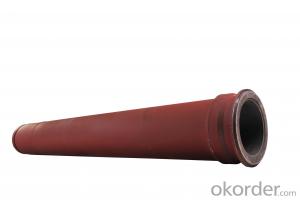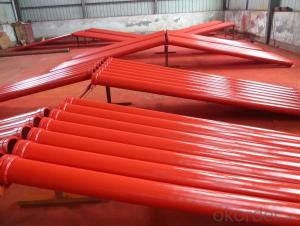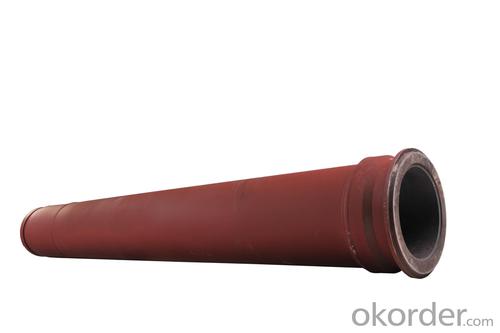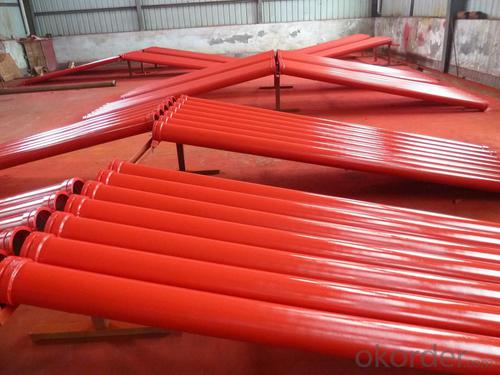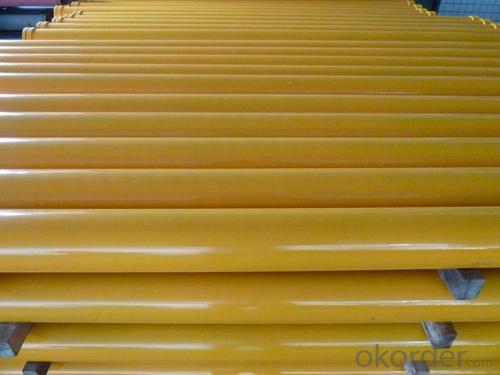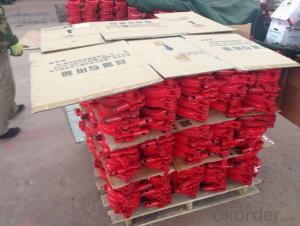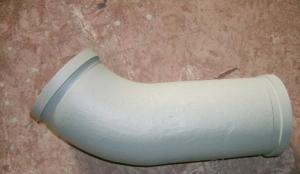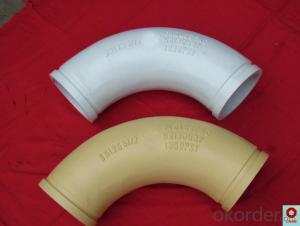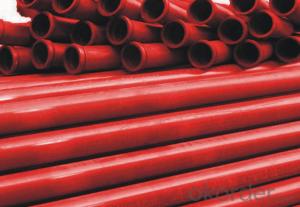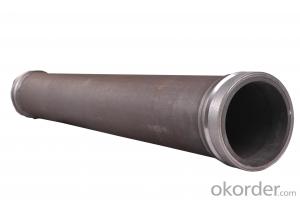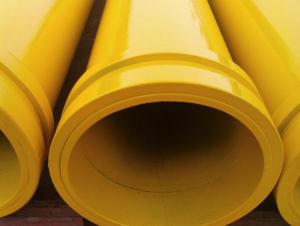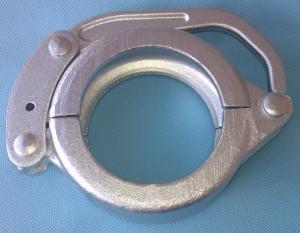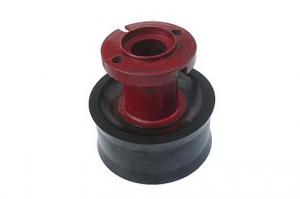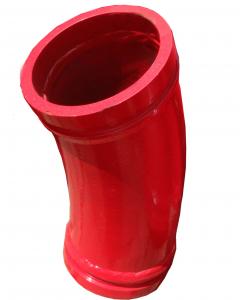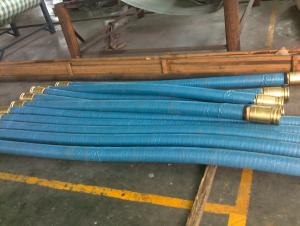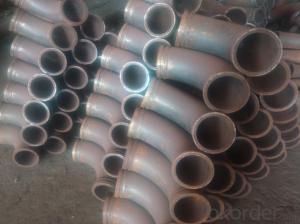Twin Wall Pipe for Concrete Pump Pipe Thickness 4.5mm Length 3000mm
- Loading Port:
- Tianjin
- Payment Terms:
- TT or LC
- Min Order Qty:
- 50 pc
- Supply Capability:
- 2000 pc/month
OKorder Service Pledge
OKorder Financial Service
You Might Also Like
Product Description:
Product Name: Twin Wall Pipe for Concrete Pump Pipe Thickness 4.5mm Length 3000mm
1. Specification
Wall thickness: inner wall is 2.5 mm 65Mn, outer wall is 2mm seamless steel
Length: 3000&2000&1000mm with wear resistant SK flange
Type: Double / twin wall
Hardness: HRC 63
Using life: 60,000-100,000(CBM)
Highlights: longest using life
Welding: Smooth welding between straight pipes and flanges
Color : as customer's requirement,usually bule or red
Surface: Electrostatic Spraying Epoxy Paint
3. Application
Concrete delivery.
4. Package
Put into containers.
FAQ:
Q1: Why buy Materials & Equipment from OKorder.com?
A1: All products have its ISO certifications, adheres to the highest standards and a commitment to supply chain safety and customer satisfaction.
Q2: How do we guarantee the quality of our products?
A2: We have established an advanced quality management system which conducts strict quality tests at every step, from raw materials to the final product. At the same time, we provide extensive follow-up service assurances as required.
Q3: How soon can we receive the product after purchase?
A3: Within three days of placing an order, we will begin production. The specific shipping date is dependent upon international and government factors, but is typically 10 to 30 workdays.
Q4: If we can produce Twin Wall Pipe for Concrete Pump Pipe Thickness 4.5mm Length 3000mm according to customers request?
A4: Yes, we can produce T Twin Wall Pipe for Concrete Pump Pipe Thickness 4.5mm Length 3000mm according to the difference country situations to make it suitable to the market and customers. We have very professional technical team to make the design.
Q5: How to make a quick resolution for after service?
A5: We have overseas branches all-around of world, If needed, the seller shall dispatch 2 engineers to the buyer's site for supervision of training. The buyer shall make available of necessary facilities &skilled personnel at site for training.

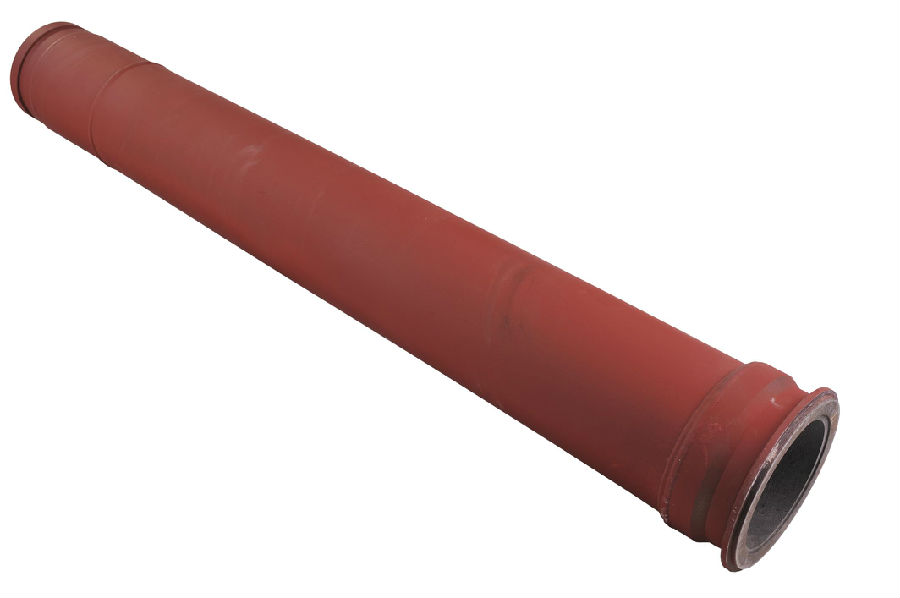
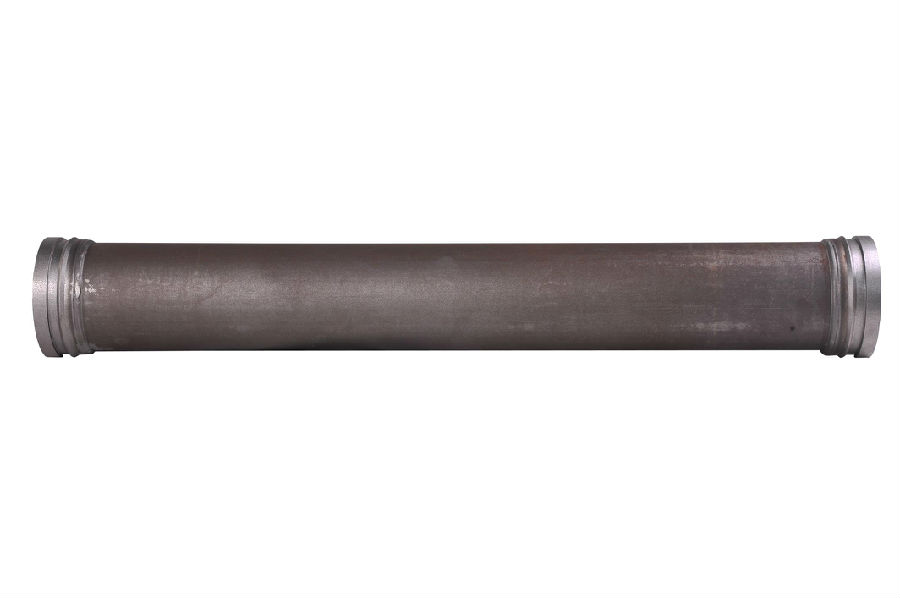
- Q: What is the function of a concrete pump hopper agitator shaft bearing?
- The primary function of the bearing on the agitator shaft of a concrete pump hopper is to offer support and facilitate smooth rotation. Typically constructed from strong materials like steel or bronze, the bearing is designed to endure substantial loads and vibrations. Its purpose is to minimize friction and prevent premature seizing or wear of the agitator shaft. Furthermore, the bearing aids in maintaining the alignment of the shaft, thereby ensuring efficient concrete mixing within the hopper. Overall, the bearing on the agitator shaft of a concrete pump hopper is essential for its reliable and consistent performance.
- Q: Can concrete pump spare parts be painted or coated for increased durability?
- Yes, concrete pump spare parts can be painted or coated to increase their durability. The paint or coating acts as a protective layer, preventing corrosion and wear and tear, thus extending the lifespan of the spare parts.
- Q: Are there any specific cleaning and maintenance procedures for concrete pump spare parts?
- Concrete pump spare parts require specific cleaning and maintenance procedures to ensure their proper functioning. Regular cleaning is crucial to remove any concrete buildup or residue from the parts. This can be achieved by either using a high-pressure water jet or immersing the parts in a cleaning solution specifically designed for concrete. It is vital to adhere to the manufacturer's instructions when using cleaning agents to guarantee the safety and effectiveness of the cleaning process. Furthermore, routine maintenance is necessary to extend the lifespan of the concrete pump spare parts and ensure their optimal performance. This involves inspecting the parts for any signs of wear, such as cracks or corrosion, and replacing them if needed. It is also important to lubricate the moving parts, like bearings or pistons, according to the manufacturer's recommendations. It is worth noting that different concrete pump spare parts may have unique cleaning and maintenance requirements. Therefore, it is advisable to consult the manufacturer's guidelines or seek guidance from a qualified technician to determine the appropriate procedures for each specific part.
- Q: How do I ensure the compatibility of mechanical components in concrete pump spare parts?
- To ensure the compatibility of mechanical components in concrete pump spare parts, there are several key steps you can follow: 1. Identify the specific make and model of your concrete pump: Different concrete pumps may have varying designs and specifications, so it is crucial to know the exact make and model of your pump. This information will help you determine the compatible spare parts for your specific pump. 2. Consult the manufacturer's documentation: Review the manufacturer's documentation, including the user manual and parts catalog, to understand the recommended spare parts for your concrete pump. These documents often provide detailed information on the compatibility of various mechanical components. 3. Seek advice from the manufacturer or authorized dealers: If you are unsure about the compatibility of certain mechanical components, it is best to reach out to the manufacturer or authorized dealers. They have extensive knowledge and experience with their products and can provide guidance on selecting compatible spare parts. 4. Consider OEM (Original Equipment Manufacturer) parts: OEM parts are specifically designed and manufactured by the original equipment manufacturer. Using OEM parts ensures the highest level of compatibility and reliability. While they may be slightly more expensive than aftermarket alternatives, they often provide better performance and longer service life. 5. Check for standardized sizing and specifications: Mechanical components, such as seals, gaskets, and bearings, often have standardized sizes and specifications. Verify that the spare parts you are considering match these standardized measurements to ensure compatibility. 6. Conduct thorough research and comparison: Before purchasing spare parts, research different suppliers and compare their offerings. Look for reputable suppliers who specialize in concrete pump spare parts and have a track record of delivering high-quality, compatible components. 7. Perform compatibility tests: If you are uncertain about the compatibility of a particular mechanical component, consider conducting compatibility tests. This can involve installing the spare part in your concrete pump and verifying its fit, function, and performance. If possible, consult with a qualified mechanic or technician to assist you in conducting these tests. By following these steps, you can ensure the compatibility of mechanical components in concrete pump spare parts, minimizing the risk of compatibility issues and ensuring the smooth operation and maintenance of your concrete pump.
- Q: How often should agitator shaft seals be replaced in a concrete pump?
- Agitator shaft seals in a concrete pump should typically be replaced every 6 to 12 months, depending on the usage and maintenance of the equipment. Regular inspection and monitoring of the seal's condition can help determine the appropriate replacement interval.
- Q: What are the indications of a clogged or damaged concrete pump filter?
- Some indications of a clogged or damaged concrete pump filter include decreased pumping pressure, reduced flow rate, increased fuel consumption, and irregular or inconsistent concrete output. Additionally, if the concrete pump filter is severely clogged or damaged, it may cause the pump to overheat or shut down completely. It is important to regularly inspect and clean or replace the filter to ensure optimal performance and prevent any potential damage to the pump.
- Q: What are the signs of a faulty concrete pump control panel?
- A faulty concrete pump control panel can be identified through various indicators. To begin with, the control panel not powering on or experiencing intermittent power loss may suggest a faulty electrical connection or a malfunctioning power supply. This can hinder the proper functioning of the panel and its ability to control the concrete pump. Furthermore, error messages or error codes displayed on the control panel may indicate issues with the internal components or sensors. These errors can range from minor malfunctions to more serious problems that require immediate attention. Additionally, an erratic behavior or unresponsive controls of the control panel can be observed. If the buttons or switches do not respond when pressed or behave inconsistently, it could signal a problem with the panel's circuitry or wiring. Moreover, the occurrence of unusual noises or vibrations emanating from the control panel may be a sign of internal mechanical issues. These could include loose or damaged components, faulty relays, or malfunctioning motors. Lastly, if the concrete pump does not perform as expected, it may be attributed to a faulty control panel. Insufficient pressure, incorrect flow rates, or difficulties in starting or stopping the pump can all indicate a malfunctioning control panel. Regardless of the indicator, it is crucial to seek the assistance of a professional technician or the manufacturer for inspection, diagnosis, and repair if there is suspicion of a faulty control panel in a concrete pump.
- Q: How does a concrete pump clamp work?
- A concrete pump clamp is a device used to secure and hold the different components of a concrete pump system together during operation. It acts as a connector between the pipes, hoses, and couplings in the system, ensuring a tight and leak-free connection. The clamp generally consists of two halves that are tightened together using bolts, creating a strong grip around the components. This tight grip prevents any movement or separation of the pipes and hoses, allowing for efficient and safe concrete pumping.
- Q: What are the different types of concrete pump hopper screens?
- There is a wide range of hopper screens available for concrete pumps, each designed to meet specific needs and requirements. 1. The wire mesh screen is the most commonly used type. It is made of woven wire mesh and prevents large debris or aggregates from entering the pump system. These screens come in various sizes and can be easily replaced when worn or damaged. 2. Perforated plate screens are made of solid metal plates with small holes or perforations. They are particularly effective in preventing fine particles or sediments from entering the pump system. Perforated plate screens are more durable than wire mesh screens and can withstand heavy-duty applications. 3. Polyurethane screens are made of polyurethane material, which has excellent resistance to abrasion and wear. These screens are commonly used in high-performance concrete pumps that handle abrasive materials. They are highly durable and can be easily cleaned or replaced when necessary. 4. Some concrete pump hoppers are equipped with a vibrating screen, which separates and removes solids or debris from the concrete mixture. The vibrating screen uses vibration to facilitate the separation process, ensuring a cleaner and more consistent concrete flow. 5. Self-cleaning screens are designed with a mechanism that prevents clogging and maintains an uninterrupted concrete flow. These screens, usually made of wire mesh or perforated plate, use mechanical or pneumatic methods to automatically remove debris from the screen surface. When selecting a hopper screen, it is crucial to consider the specific requirements of your concrete pumping operation. Factors such as aggregate size, presence of fine particles, and abrasiveness should be taken into account to ensure optimal performance and longevity.
- Q: What are the signs of a worn-out concrete pump piston?
- Some signs of a worn-out concrete pump piston may include decreased pumping efficiency, loss of pressure, increased noise or vibrations during operation, inconsistent concrete flow, and visible wear or damage on the piston surface.
Send your message to us
Twin Wall Pipe for Concrete Pump Pipe Thickness 4.5mm Length 3000mm
- Loading Port:
- Tianjin
- Payment Terms:
- TT or LC
- Min Order Qty:
- 50 pc
- Supply Capability:
- 2000 pc/month
OKorder Service Pledge
OKorder Financial Service
Similar products
Hot products
Hot Searches
